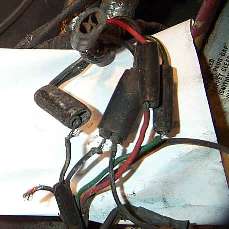
Chicagoland MG Club

Back to Archives
Submit an article
Cover
Intro & Club Officers
The Steering Column
February Meeting Rept
Welcome New Members
Annual Awards 2000
Go Brit Baby, Tech Ses
Tech Sessions Past
Tech Sessions Coming
Regalia Items Available
Regalia Order Form
Just a Simple Wrench
The Rally Corner
Missouri Endur.Rally
Missouri Endur.Regist
MG 2001 MG Odyssey
Dues are Due
Publication Deadline
Classifieds
Coming Events
Back Cover
|
|

Just a Simple Wrench
 by Ann & Jake Snyder
by Ann & Jake Snyder
One More Spare Part
We were on our way to a meeting. It was winter, already dark, and we had the headlamps on as we always do, day or night. (We have known of too many MGs that have been hit by other drivers who did not see the smaller vehicles, and it is easier to change and repair an alternator than to replace body panels.) But both headlamps were not on all the time - the right one seemed to be going on and off at random. Very likely, we thought, that a wire had become loose and was on the verge of contacting a ground and burning out a big chunk of the wiring loom. We checked the wiring that supplied the right headlamp when we got to the parking lot of the restaurant where the meeting was being held. What we found showed that we had not checked these wires very carefully in quite a while. The red/blue of the right low beam had broken off, and occasionally, as we were driving, would touch and reweld itself together for a little while, and then vibrate loose when we went over a bump. Over the years, the insulation had receded and the individual strands of wire had corroded and broken off close to the bullet tips. As shown in the photo, when enough of the strands break off, the remaining strands are more likely to burn off.
 We were not comfortable with leaving a loose live wire dangling about for the trip home, and neither were we comfortable with trusting that the left headlamp wiring was in any better condition. After spending too long in the dark parking lot, looking through our black bags of tools and parts with the winter wind reminding us of the warmth and cheer to be had at the meeting, we came up with a jumper wire with alligator clips and two disposable vinyl gloves to use to insulate the clips. Rude as the repair was, we made it home after the meeting with no further mishaps. And the rough-and-ready repair was replaced with wire leads with soldered bullet tips and fit into new connectors to replace the corroded originals.
We were not comfortable with leaving a loose live wire dangling about for the trip home, and neither were we comfortable with trusting that the left headlamp wiring was in any better condition. After spending too long in the dark parking lot, looking through our black bags of tools and parts with the winter wind reminding us of the warmth and cheer to be had at the meeting, we came up with a jumper wire with alligator clips and two disposable vinyl gloves to use to insulate the clips. Rude as the repair was, we made it home after the meeting with no further mishaps. And the rough-and-ready repair was replaced with wire leads with soldered bullet tips and fit into new connectors to replace the corroded originals.
The problem in making an adequate repair on the road should never have arisen, of course, because everyone always checks their MG regularly and makes all necessary and prudent repairs. However, the real world is the one for which we carry parts and tools, and this experience suggested that we should have something fast and simple to repair wiring that had gone bad, if not for us, then for another club member whose MG might be similarly afflicted. We took some six-inch lengths of wire of various colors from an old wiring harness that we use for replacement parts, and soldered bullet tips to them. The only trick to this is having bullet tips with the right size hole in them to make the soldering quick and simple. There are four different sizes available from British Wiring, Inc. (20449 Ithaca, Olympia Fields, IL 60461, or www.britishwiring.com). A useful size is Item 328, which is good for 14 gauge wire. The rest of the wiring repair kit was a few butt connectors to permit a quick crimp connection between the damaged section and the new patch wires. We got butt connectors of the size coded blue, and also got a crimping tool, though a pair of pliers would work in a pinch. Using a crimped butt connector is an emergency repair, and should be replaced with a soldered splice, weather-proofed with shrink tubing, at the earliest opportunity because a crimped connector will very soon corrode and give a poor contact.
A quick check on the car showed that the worst of the connections were behind the grill, where there is the most exposure to rain, dirt and salt. Unfortunately, the wires here are usually pushed down under the apron that receives the bonnet, which makes inspection more difficult and less likely. That is another way of saying that using the emergency repair wires will be more likely than not.
 
|
|


 by Ann & Jake Snyder
by Ann & Jake Snyder
